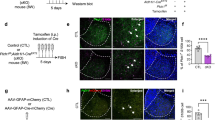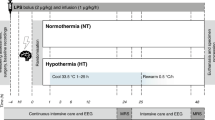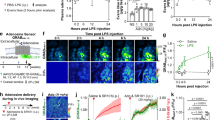Abstract
PI-PLC, a critical enzyme of the phosphoinositide (PI) signaling pathway, mediates many physiological functions in the brain, including cellular plasticity. Stress-induced learned helplessness (LH) in animals serves as a model of behavioral depression. Recently, we observed that repeated stress prolongs the duration of LH behavior in rats, enabling us to compare neurobiologic abnormalities in acute and chronic depression. Here we examine whether LH behavior is associated with alterations in phospholipase C (PLC), and whether repetition of inescapable shock has similar or dissimilar effects on PLC to those of the single-stress paradigm. Rats were exposed to inescapable shock either once on day 1, or twice, on days 1 and 7. Rats were tested for escape latency on days 2 and 4 after day 1 inescapable shock or on days 2, 8, and 14 after day 1 and 7 inescapable shock. PI-PLC activity and mRNA and protein expression of three different PLC isozymes were determined in the frontal cortex and hippocampus. Higher escape latencies were observed in LH rats tested on day 2 after single inescapable shock and on day 14 after repeated inescapable shock. Single inescapable shock reduced PI-PLC activity in the frontal cortex and hippocampus of LH rats. On the other hand, repeated inescapable shock not only reduced PI-PLC activity in these brain areas of LH rats but also selectively decreased the expression of PLC β1 and PLC γ1 isozymes. Our results suggest different responsiveness at the level of PI-PLC after single vs repeated stress, and that reductions in PLC may be critical in the pathophysiology of depression and other stress-related disorders.
Similar content being viewed by others
Log in or create a free account to read this content
Gain free access to this article, as well as selected content from this journal and more on nature.com
or
References
Allen V, Swigart P, Cheung R, Cockcroft S, Katan M (1997). Regulation of inositol lipid-specific phospholipase cdelta by changes in Ca2+ ion concentrations. Biochem J 327: 545–552.
Amin AR, Ichigotani Y, Oo ML, Biswas MH, Yuan H, Huang P et al (2003). The PLC–PKC cascade is required for IL-1β-dependent Erk and Akt activation: their role in proliferation. Int J Oncol 23: 1727–1731.
Anisman H, Zacharko RM (1992). Depression as a consequence of inadequate neurochemical adaptation in response to stressors. Br J Psychiatry 160: 36–43.
Arango V, Ernsberger P, Marzuk PM, Chen JS, Tierney H, Stanley M et al (1990). Autoradiographic demonstration of increased serotonin 5HT2 and β-adrenergic receptor binding sites in the brain of suicide victims. Arch Gen Psychiatry 47: 1038–1047.
Arora RC, Meltzer HY (1989a). Increased serotonin2 (5HT2) receptor binding as measured by [3H]lysergic diethylamide ([3H]LSD) in the blood platelets of depressed patients. Life Sci 44: 725–734.
Arora RC, Meltzer HY (1989b). Serotonergic measures in the brains of suicide victims. 5HT2 binding sites in the frontal cortex of suicide victims and control subjects. Am J Psychiatry 146: 730–736.
Berk M, Plein H, Ferreira D (2001). Platelet glutamate receptor supersensitivity in major depressive disorder. Clin Neuropharmacol 24: 129–132.
Biegon A, Weizman A, Karp L, Ram A, Tiano S, Wolff M (1987). Serotonin 5HT2 receptor binding on blood platelets: a peripheral marker for depression? Life Sci 41: 2485–2492.
Carstens ME, Engelbrecht AH, Russell VA, Aalbers C, Gagiano CA, Chalton DO et al (1987). Beta-adrenoceptors on lymphocytes of patients with major depressive disorders. Psychiatry Res 20: 239–248.
De Kloet ER, De Kock S, Schild V, Veldhuis HD (1988). Antiglucocorticoid RU38486 attenuates retention of a behaviour and disinhibits the hypothalamic–pituitary–adrenal axis at different brain sites. Neuroendocrinology 47: 109–115.
Dekker LV, Palmer RH, Parker PJ (1995). The protein kinase C and protein kinase C related gene families. Curr Opin Struct Biol 5: 396–402.
Drugan R, Morrow A, Weizman R, Weizman A, Deutsch S, Crawley J et al (1989). Stress-induced behavioral depression is associated with a decrease in GABA receptor-mediated chloride ion flux and brain benzodiazepine receptor occupancy. Brain Res 487: 45–51.
Drugan RC, Crawley JN, Paul SM, Skolnick P (1987). Buspirone attenuates learned helplessness behavior in rats. Drug Dev Res 10: 63–67.
Drugan RC, Maier SF (1983). Analgesic and opioid involvement in the shock-elicited activity and escape deficits produced by inescapable shock. Learn Motiv 14: 30–47.
Duman RS, Malberg J, Nakagawa S, D'Sa C (2000). Neuronal plasticity and survival in mood disorders. Biol Psychiatry 48: 732–739.
Dwivedi Y, Agrawal AK, Rizavi HS, Pandey GN (2002). Antidepressants reduce phosphoinositide-specific phospholipase C (PI-PLC) activity and the mRNA and protein expression of selective PLC β1 isozyme in rat brain. Neuropharmacology 43: 1269–1279.
Dwivedi Y, Janicak PG, Pandey GN (1998). Elevated [3H]inositol 1,4,5-trisphosphate binding sites and expressed inositol 1,4,5-trisphophate receptor protein level in platelets of depressed patients. Psychopharmacology (Berl) 138: 47–54.
Dwivedi Y, Mondal AC, Shukla PK, Rizavi HS, Lyons J (2004). Altered protein kinase A in brain of learned helpless rats: effects of acute and repeated stress. Biol Psychiatry 56: 30–40.
Dwivedi Y, Pandey GN (1999). Repeated administration of dexamethasone increases phosphoinositide-specific phospholipase C activity and mRNA and protein expression of the phospholipase C β1 isozyme in rat brain. J Neurochem 73: 780–790.
Dwivedi Y, Rizavi HS, Rao JS, Pandey GN (2000). Modifications in the phosphoinositide signaling pathway by adrenal glucocorticoids in rat brain: focus on phosphoinositide-specific phospholipase C and inositol 1,4,5-trisphosphate. J Pharmacol Exp Ther 295: 244–254.
Edwards E, Harkins K, Wright G, Henn FA (1990). Effects of bilateral adrenalectomy on the induction of learned helplessness behavior. Neuropsychopharmacology 3: 109–114.
Emori Y, Homma Y, Sorimachi H, Kawasaki H, Nakanishi O, Suzuki K et al (1989). A second type of rat phosphoinositide-specific phospholipase C containing a src-related sequence not essential for phosphoinositide-hydrolyzing activity. J Biol Chem 264: 21885–21890.
Extein I, Tallman J, Smith CC, Goodwin FK (1979). Changes in lymphocyte beta-adrenergic receptors in depression and mania. Psychiatry Res 1: 191–197.
Ferretti C, Blengio M, Gamalero SR, Ghi P (1995). Biochemical and behaviour changes induced by acute stress in a chronic variate stress model of depression: the effect of amitriptyline. Eur J Pharmacol 280: 19–26.
Grahn RE, Hammack SE, Will MJ, O'Connor KA, Deak T, Sparks PD et al (2002). Blockade of α1-adrenoreceptors in the dorsal raphe nucleus prevents enhanced conditioned fear and impaired escape performance following uncontrollable stressor exposure in rats. Behav Brain Res 134: 387–392.
Greenberg L, Edwards E, Henn FA (1989). Dexamethasone suppression test in helpless rats. Biol Psychiatry 26: 530–532.
Haracz JL, Minor TR, Wilkins JN, Zimmermann EG (1988). Learned helplessness: an experimental model of the DST in rats. Biol Psychiatry 23: 388–396.
Hellhammer DH, Rea MA, Bell M, Belkien L, Ludwig M (1984). Learned helplessness: effects on brain monoamines and the pituitary-gonadal axis. Pharmacol Biochem Behav 21: 481–485.
Henn FA, Edwards E, Muneyyirci J (1993). Animal models of depression. Clin Neurosci 1: 152–156.
Hrdina PD, Bakish D, Chudzik J, Ravindran A, Lapierre YD (1995). Serotonergic markers in platelets of patients with major depression: upregulation of 5HT2 receptors. J Psychiatry Neurosci 20: 11–19.
Jesberger JA, Richardson JS (1985). Animal models of depression: parallels and correlates to severe depression in humans. Biol Psychiatry 20: 764–784.
Kamat A, Carpenter G (1997). Phospholipase C-γ1: regulation of enzyme function and role in growth factor-dependent signal transduction. Cytokine Growth Factor Rev 8: 109–117.
Kellar KJ, Cascio CS, Butler JA, Kurtzke RN (1981). Differential effects of electroconvulsive shock and antidepressant drugs on serotonin2 receptors in rat brain. Eur J Pharmacol 69: 515–518.
Kusumi I, Koyama T, Yamashita I (1994). Serotonin-induced platelet intracellular calcium mobilization in depressed patients. Psychopharmacology (Berl) 113: 322–327.
Kusumi I, Suzuki K, Sasaki Y, Kameda K, Koyama T (2000). Treatment response in depressed patients with enhanced Ca mobilization stimulated by serotonin. Neuropsychopharmacology 23: 690–696.
Lowther S, De Paermentier F, Crompton MR, Katona CL, Horton RW (1994). Brain 5-HT2 receptors in suicide victims: violence of death, depression and effects of antidepressant treatment. Brain Res 642: 281–289.
Magliozzi JR, Gietzen D, Maddock RJ, Haack D, Doran AR, Goodman T et al (1989). Lymphocyte beta-adrenoreceptor density in patients with unipolar depression and normal controls. Biol Psychiatry 26: 15–25.
Maier SF, Grahn RE, Watkins LR (1995). 8-OH-DPAT microinjected in the region of the dorsal raphe nucleus blocks and reverses the enhancement of fear conditioning and interference with escape produced by exposure to inescapable shock. Behav Neurosci 109: 404–412.
Malberg JE, Duman RS (2003). Cell proliferation in adult hippocampus is decreased by inescapable stress: reversal by fluoxetine treatment. Neuropsychopharmacology 28: 1562–1571.
Mann JJ, Stanley M, BcBride PA, McEwen BS (1986). Increased serotonin2 and β-adrenergic receptor binding in the frontal cortices of suicide victims. Arch Gen Psychiatry 43: 954–959.
Maswood S, Barter JE, Watkins LR, Maier SF (1998). Exposure to inescapable but not escapable shock increases extracellular levels of 5HT in the dorsal raphe nucleus of the rat. Brain Res 783: 115–120.
Mendelson SD (2000). The current status of the platelet 5HT2A receptor in depression. J Affect Disord 57: 13–24.
Mikuni M, Kusumi I, Kagaya A, Kuroda Y, Mori H, Takahashi K (1991). Increased 5HT2 receptor function as measured by serotonin-stimulated phosphoinositide hydrolysis in platelets of depressed patients. Prog Neuropsychopharmacol Biol Psychiatry 15: 49–61.
Minor T, Pelleymounter M, Maier S (1988). Uncontrollable shock, forebrain norepinephrine and stimulus selection during choice-escape learning. Psychobiology 16: 135–145.
Minor TR, Rowe MK, Soames Job RF, Ferguson EC (2001). Escape deficits induced by inescapable shock and metabolic stress are reversed by adenosine receptor antagonists. Behav Brain Res 120: 203–212.
Murthy SN, Lomasney JW, Mak EC, Lorand L (1999). Interactions of G(h)/transglutaminase with phospholipase Cdelta1 and with GTP. Proc Natl Acad Sci USA 96: 11815–11819.
Nestler EJ, Gould E, Manji H, Buncan M, Duman RS, Greshenfeld H et al (2002). Preclinical models: status of basic research in depression. Biol Psychiatry 52: 503–528.
Pandey GN, Brown B, Davis JM (1985). Effect of treatment with some atypical antidepressants on [3H]DHA binding in rat brain. Drug Dev Res 5: 251–259.
Pandey GN, Dwivedi Y, Pandey SC, Teas SS, Conley RR, Roberts RC et al (1999). Low phosphoinositide-specific phospholipase C activity and expression of phospholipase C β1 protein in the prefrontal cortex of teenage suicide subjects. Am J Psychiatry 156: 1895–1901.
Pandey GN, Dwivedi Y, Rizavi HS, Ren X, Pandey SC, Pesold C et al (2002). Higher expression of serotonin 5HT2A receptors in the postmortem brains of teenage suicide victims. Am J Psychiatry 159: 419–429.
Pandey GN, Janicak PG, Davis JM (1987). Decreased beta-adrenergic receptors in the leukocytes of depressed patients. Psychiatry Res 22: 265–273.
Pandey GN, Pandey SC, Dwivedi Y, Sharma RP, Janicak PG, Davis JM (1995). Platelet serotonin2A receptors: a potential biological marker for suicidal behavior. Am J Psychiatry 152: 850–855.
Patterson RL, van Rossum DB, Ford DL, Hurt KJ, Bae SS, Suh PG et al (2002). Phospholipase C-gamma is required for agonist-induced Ca2+ entry. Cell 111: 529–541.
Peroutka SJ, Snyder SH (1980). Long-term antidepressant treatment decreases spiroperidol-labeled serotonin receptor binding. Science 210: 88–90.
Petty F, Kramer G, Wilson L (1992). Prevention of learned helplessness: in vivo correlation with cortical serotonin. Pharmacol Biochem Behav 43: 361–367.
Petty F, Kramer G, Wilson L, Chae Y-L (1993). Learned helplessness and in vivo hippocampal norepinephrine release. Pharmacol Biochem Behav 46: 231–235.
Petty F, Sherman AD (1983). Learned helplessness induction decreases in vivo cortical serotonin release. Pharmacol Biochem Behav 18: 649–650.
Plein H, Berk M (2000). Changes in the platelet intracellular calcium response to serotonin in patients with major depression treated with electroconvulsive therapy: state or trait marker status. Int Clin Psychopharmacol 15: 93–98.
Plotsky PM, Owens MJ, Nemeroff CB (1998). Psychoneuroendocrinology of depression. Hypothalamic–pituitary–adrenal axis. Psychiatr Clin North Am 21: 293–307.
Rebecchi MJ, Pentyala SN (2000). Structure, function, and control of phosphoinositide-specific phospholipase C. Pharmacol Rev 80: 1291–1335.
Rhee SG (2001). Regulation of phosphoinositide-specific phospholipase C. Annu Rev Biochem 70: 281–312.
Rhee SG, Kim H, Suh P-G, Choi WC (1991). Multiple forms of phosphoinositide-specific phospholipase C and different modes of activation. Biochem Soc Trans 19: 337–341.
Ross CA, MacCumber MW, Glatt CE, Snyder SH (1989). Brain phospholipase C isozymes: differential mRNA localizations by in situ hybridization. Proc Natl Acad Sci USA 86: 2923–2927.
Strohle A, Holsboer F (2003). Stress responsive neurohormones in depression and anxiety. Pharmacopsychiatry 36: S207–S214.
Sulser F (1979). New perspectives on the mode of action of antidepressant drugs. Trends Pharmacol Sci 12: 92–94.
Tanaka O, Kondo H (1994). Localization of mRNA for three novel members (β3, β4 and γ2) of phospholipase C family in mature rat brain. Neurosci Lett 182: 17–20.
Turecki G, Grof P, Cavazzoni P, Duffy A, Grof E, Ahrens B et al (1998). Evidence for a role of phospholipase C-γ1 in the pathogenesis of bipolar disorder. Mol Psychiatry 3: 534–538.
Velbinger K, De Vry J, Jentzsch K, Eckert A, Henn F, Muller WE (2000). Acute stress induced modifications of calcium signaling in learned helpless rats. Pharmacopsychiatry 33: 132–137.
Weiss J, Stone E, Harrell N (1970). Coping behavior and brain norepinephrine levels in rats. J Comp Physiol Psychol 72: 153–160.
Wu J, Kramer GL, Kram M, Steciuk M, Crawford IL, Petty F (1999). Serotonin and learned helplessness: a regional study of 5HT1A, 5HT2A receptors and the serotonin transport site in rat brain. J Psychiatr Res 33: 17–22.
Acknowledgements
This study is supported by grants from the NIMH (RO1MH 68777; KO1MH01836) and a Young Investigator Award from the American Foundation for Suicide Prevention to Dr Yogesh Dwivedi.
Author information
Authors and Affiliations
Corresponding author
Rights and permissions
About this article
Cite this article
Dwivedi, Y., Mondal, A., Rizavi, H. et al. Single and Repeated Stress-Induced Modulation of Phospholipase C Catalytic Activity and Expression: Role in LH Behavior. Neuropsychopharmacol 30, 473–483 (2005). https://doi.org/10.1038/sj.npp.1300605
Received:
Revised:
Accepted:
Published:
Issue date:
DOI: https://doi.org/10.1038/sj.npp.1300605
Keywords
This article is cited by
-
Proteomic Analysis of the Hippocampus in Mouse Models of Trigeminal Neuralgia and Inescapable Shock-Induced Depression
Neuroscience Bulletin (2018)
-
Loss of Glial Cells of the Hippocampus in a Rat Model of Post-traumatic Stress Disorder
Neurochemical Research (2015)
-
The Involvement of MicroRNAs in Major Depression, Suicidal Behavior, and Related Disorders: A Focus on miR-185 and miR-491-3p
Cellular and Molecular Neurobiology (2014)
-
Little things on which happiness depends: microRNAs as novel therapeutic targets for the treatment of anxiety and depression
Molecular Psychiatry (2012)
-
A Role for the PKC Signaling System in the Pathophysiology and Treatment of Mood Disorders: Involvement of a Functional Imbalance?
Molecular Neurobiology (2011)



